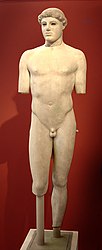S-curve (art)

In the visual arts, an S-curve is an "S"-shaped curve which serves a wide variety of compositional purposes. It can help guide the viewer's eye through the image to the main subject at the end of the curve, but can also serve as a subject in and of itself.[1] It has been variously described as dynamic,[2] feminine,[2] restful,[1] and hypnotic.[1] The S-curve is particularly prominent in a vertical composition, where it may be stacked to form a double S-curve for maximum effect.[2]
In sculpture
In Ancient Greek and Roman sculpture, the S-curve is a traditional art concept where the figure's body and posture is depicted like a sinuous or serpentine manner. It is related to and is an extension of the art term of contrapposto which is when a figure is depicted slouching or placing one's weight and thus center of gravity to one side. However, the S Curve involves more of the body than the contrapposto, and is therefore considered to be a more advanced technical development. The "S Curve" concept was probably invented by the famous Greek sculptor Praxiteles, son of Kifissodotos, who lived in the 4th century BC.[3]
The Indian tribhanga ("three bend") pose is similar, but generally more pronounced, often with the neck also curved to one side. This goes back to at least 100 BC.[4]
- Examples
-
The Venus de Milo depicts a S Curve body shape
-
Note that there is only a slight weight shift in the Kritios Boy; thus, it is a contrapposto.
References
- ^ a b c Taylor, David (21 February 2015). Understanding Composition: The Expanded Guide. East Sussex: Ammonite Press. p. 68. ISBN 9781781451083.
- ^ a b c Gallovich, Tom (2015). Power Composition for Photography: Develop Your Artistic Eye. Buffalo: Amherst Media. p. 62. ISBN 9781608958474.
- ^ "Art Of Ancient Greece, Brief History (1050- 50 b.C.), Georgia Kokkorou- Aleyra
- ^ Craven, Roy C., Indian Art: A Concise History, p. 70, 1987, Thames & Hudson (Praeger in USA), ISBN 0500201463



